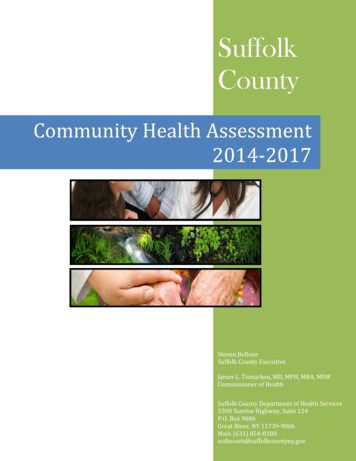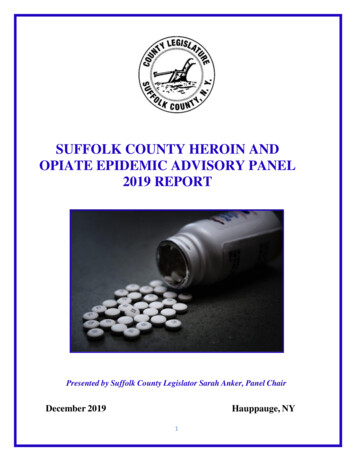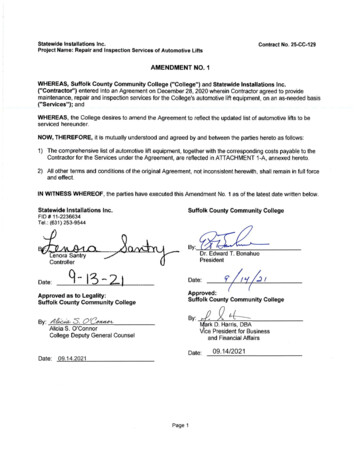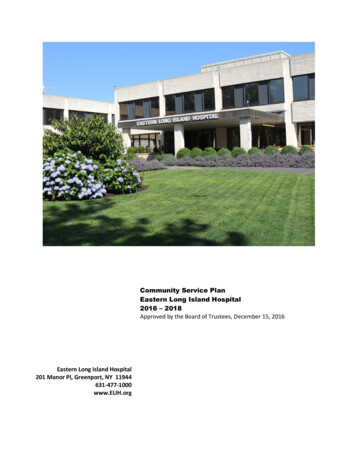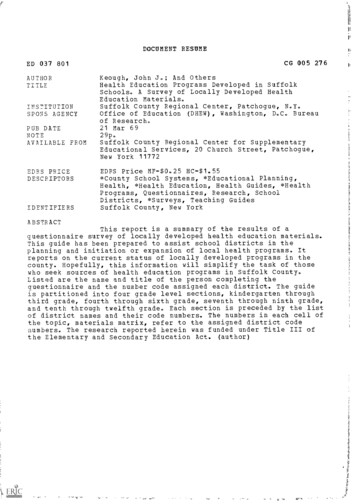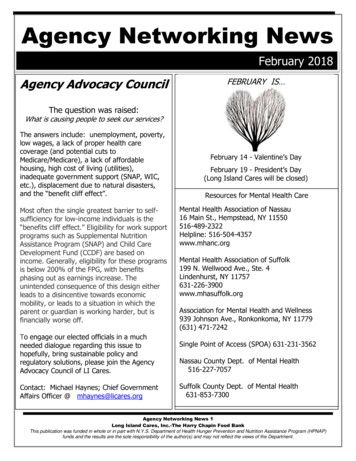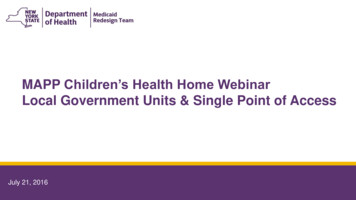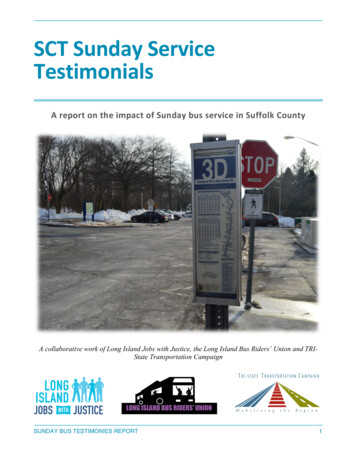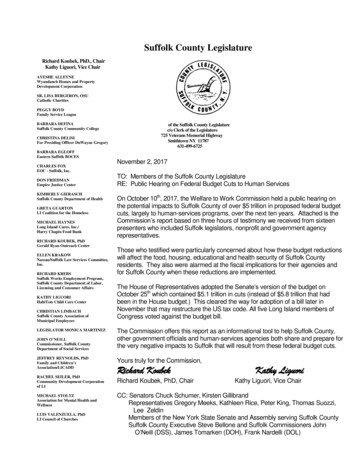
Transcription
Suffolk County LegislatureRichard Koubek, PhD., ChairKathy Liguori, Vice ChairAYESHE ALLEYNEWyandanch Homes and PropertyDevelopment CorporationSR. LISA BERGERON, OSUCatholic CharitiesPEGGY BOYDFamily Service LeagueBARBARA DEFINASuffolk County Community CollegeCHRISTINA DELISIFor Presiding Officer DuWayne Gregoryof the Suffolk County Legislaturec/o Clerk of the Legislature725 Veterans Memorial HighwaySmithtown NY 11787631-499-6725BARBARA EGLOFFEastern Suffolk BOCESof the SuffolkCHARLES FOXEOC - Suffolk, Inc.c/o Clerk of the Legislat725 Veterans MemorialDON FRIEDMANSmithtown NY 11787Empire Justice Center631-499-6725KIMBERLY GIERASCHSuffolk County Department of HealthGRETA GUARTONLI Coalition for the HomelessMICHAEL HAYNESLong Island Cares, Inc./Harry Chapin Food BankRICHARD KOUBEK, PhDGerald Ryan Outreach CenterELLEN KRAKOWNassau/Suffolk Law Services Committee,Inc.RICHARD KREBSSuffolk Works Employment Program,Suffolk County Department of Labor,Licensing and Consumer AffairsKATHY LIGUORIHabiTots Child Care CenterCHRISTIAN LIMBACHSuffolk County Association ofMunicipal EmployeesLEGISLATOR MONICA MARTINEZJOHN O’NEILLCommissioner, Suffolk CountyDepartment of Social ServicesJEFFREY REYNOLDS, PhDFamily and Children’sAssociation/LICADDRACHEL SEILER, PhDCommunity Development Corporationof LIMICHAEL STOLTZAssociation for Mental Health andWellnessLUIS VALENZUELA, PhDLI Council of ChurchesNovember 2, 2017TO: Members of the Suffolk County LegislatureRE: Public Hearing on Federal Budget Cuts to Human ServicesOn October 10th, 2017, the Welfare to Work Commission held a public hearing onthe potential impacts to Suffolk County of over 5 trillion in proposed federal budgetcuts, largely to human-services programs, over the next ten years. Attached is theCommission’s report based on three hours of testimony we received from sixteenpresenters who included Suffolk legislators, nonprofit and government agencyrepresentatives.Those who testified were particularly concerned about how these budget reductionswill affect the food, housing, educational and health security of Suffolk Countyresidents. They also were alarmed at the fiscal implications for their agencies andfor Suffolk County when these reductions are implemented.The House of Representatives adopted the Senate’s version of the budget onOctober 25th which contained 5.1 trillion in cuts (instead of 5.8 trillion that hadbeen in the House budget.) This cleared the way for adoption of a bill later inNovember that may restructure the US tax code. All five Long Island members ofCongress voted against the budget bill.The Commission offers this report as an informational tool to help Suffolk County,other government officials and human-services agencies both share and prepare forthe very negative impacts to Suffolk that will result from these federal budget cuts.Yours truly for the Commission,Richard KoubekRichard Koubek, PhD, ChairKathy LiguoriKathy Liguori, Vice ChairCC: Senators Chuck Schumer, Kirsten GillibrandRepresentatives Gregory Meeks, Kathleen Rice, Peter King, Thomas Suozzi,Lee ZeldinMembers of the New York State Senate and Assembly serving Suffolk CountySuffolk County Executive Steve Bellone and Suffolk Commissioners John1O’Neill (DSS), James Tomarken (DOH), Frank Nardelli (DOL)
Suffolk County LegislatureWelfare to Work CommissionOf the Suffolk County LegislatureReport to the Suffolk County LegislatureOn the Welfare to Work Commission’sPublic Hearing“The 2018 Federal Budget Proposals:A Fiscal and Human Rights Crisis for Suffolk?”November 2, 20172
ContentsPageIntroduction: “All We Wil Be Able to Do Is Offer Sympathy”3A Chronic Pattern of Underfunding6Food Insecurity7Housing Insecurity8Educational Insecurity10Health Insecurity11Conclusion13Appendix A: Participants in the Federal Budget Hearing15Appendix B: An Overview of the Proposed Federal Budget Cuts toHuman-Services Programs, Testimony of Don Freidman, Esq.163
Introduction: “All We Will Be Able to Do Is Offer Sympathy”One of the Welfare to Work Commission’s goals for 2017 is “to monitor changes in federalTANF law and policy that may be implemented by the Trump Administration, with specialattention to education and training opportunities for SWEP clients.” As the Commissionlearned of human-services cuts – with possible impacts on SWEP clients and programs proposed first in President Donald Trump’s federal budget released in the spring, then in theHouse of Representatives’ budget, the Commission formed an ad hoc committee to exploreholding a public hearing on the potential impacts that these budget proposals might have onSuffolk County. In consultation with Presiding Officer DuWayne Gregory, the Commissionscheduled the hearing for October 10th, the week before the Legislature held hearings on theSuffolk County Recommended 2018 Budget, in the hope that the hearing might provide abroader context for the County’s budget deliberations.The three-hour hearing included testimony from Commission member Don Friedman of theEmpire Justice Center, an attorney with broad public-policy analytical experience, who hadbeen periodically briefing the Commission on the federal budget following release of theTrump Administration’s budget, and then the House budget. The hearing received testimonyfrom 14 Suffolk County contract agencies, other nonprofit organizations and the HuntingtonHousing Authority. The Commission also received statements from Presiding OfficerGregory and Legislators Monica Martinez and Leslie Kennedy. A full list of those whoprovided testimony can be found in Appendix A.Mr. Friedman’s full budget overview can be found in Appendix B. Mr. Friedman provided thesummary below of the most severe human-services reductions contained in the Housebudget which, at the time of the hearing on October 10th, was considered the most-likely tobe adopted in all or in part. On October 26, 2017, the House adopted the Senate version ofthe budget, which contains 5.1 trillion in non-defense cuts over ten years instead of theHouse’s proposed 5.8 trillion in cuts. The adopted budget also contains a blueprint for taxcuts that will be adopted in a separate bill sometime around Thanksgiving.The House budget adopted on October 26th was opposed by all five Long Islandcongressional representatives: Gregory Meeks (D); Kathleen Rice (D); Thomas Suozzi (D),Peter King (R); Lee Zeldin (R). It appears that Congressmen King and Zeldin broke withtheir Party over the budget’s inclusion of a provision that would eliminate the federal taxdeduction for local and State taxes.1Overall: the original House proposal contained 5.8 trillion in non-defense cuts over 10years. Programs for low and moderate income Americans account for about onequarter of the non-defense budget, but account for fully half of the budgetcuts, or 2.9 trillion. By 2027, there will have been a total of 36% in cuts to these programs1Brune, Tom. “Budget Plan OKd,” Newsday, October 27, 2017.4
Aside from the ACA repeal, the budget calls for cuts in Medicaid and otherhealth programs., job training, vocation education and housing assistanceThere will be a 150 billion cut to the SNAP program to be phased in. By2027, there will have been a 47% cut to the SNAP program, which will alsohave been converted to a block grant-like program, giving more discretionaryauthority to the states to, among other things, change benefit level andeligibility criteria 500 billion will be cut from another array of programs, including schoolmeals, SSI, and refundable tax credits“Savings” will be generated by more onerous verification requirements for theEarned Income Tax Credit, along with cuts in child tax credit eligibilityUnspecified cuts threaten the well-being of child care programs, foster careand adoption assistance and the TANF programThe budget includes 75 billion in cuts to the Pell Grant Program to helpstudents meet college costs, even though Pell Grant funding is already at itslowest level since the program began. In addition, there will be 120 B. cutsto student loan programs.On top of all these cuts, 330 billion will be saved by reducing improperpayments. These savings are built on what many believe is the myth of“waste, fraud and abuse.” Unfortunately what generally occurs is that theprojected savings amount, upon which the budget is based, is never met, soadditional cuts must be made to achieve the projected savings.The organizations and agencies that provided testimony at the Commission’s October 10thhearing offer a wide array of services to poor and vulnerable Suffolk residents in foodsecurity, housing, job training and education including pre-school programs and health care– all of which will be negatively impacted by the proposed federal budget cuts.Speaker after speaker warned of the dire consequences that would befall their agency aswell as the fragile people they serve. Anne Stewart, Director of Program, Planning andGrants for EOC of Long Island, best summarized the collective alarm generated by theseproposed cuts:“We will have to choose whom we serve, and with already strained resources, all wewill be able to do is offer sympathy.”What follows are highlights of the testimony provided at the hearing, which focused on thechronic pattern of federal government underfunding of human-services programs as well asthe negative impacts of the proposed cuts in four policy areas: food security; housing;education; health care. It should be noted that there are other human-services policy areasaffected by the proposed budget cuts that were not discussed at the October 10th hearingsuch as cuts to Pell college student grants and cuts to programs for persons with disabilities.5
For a more complete assessment of the proposed 2018 federal budget cuts, see analysesby the Center for American Progress and the Center for Budget and Policy Priorities.2A Chronic Pattern of UnderfundingIn his opening remarks, Commission Chair Richard Koubek reported that chronic flat fundingor underfunding of human services by the federal and State governments has been aproblem observed by the Commission since its creation in 2003. This summer, he noted,Long Island Business News featured a headline story about how Long Island nonprofitcontract agencies are using reserve funds to cover their expenses delivering services to theCounty. In addition, because inadequate State and federal funding squeezes the County,these agencies are now required to pay for their own administrative costs incurred deliveringservices, outside of their County contract funding.3As Alison Puglia, Vice President of Programs and Agency Relations, Island Harvest, statedin her testimony:“On Long Island alone there are more than 6,000 nonprofit organizations providingimportant work to Long Islanders in need. Our budgets are held together by thethinnest of margins, dependent on funds from the public and private sectors. In mostcases, these organizations are under-staffed and overworked. Together we fight andin some cases compete for every dollar.”The formula has been quite consistent: the federal government flat funds or reduces fundingto the State for human services and the State then reduces funding to Suffolk County andthe County is thereby forced to flat fund or reduce funding to its contract agencies.Mr. Koubek provided a concrete example. The Commission’s 2012 report on poverty usedfunding for Catholic Charities’ Mental Health Services to illustrate this chronic revenuesqueeze. The report documented that the unit cost for Catholic Charities to provide mentalhealth services was 82. The County reimbursed Catholic Charities 38 per unit of serviceusing federal and State funds. Each patient had a 25 copay bringing the totalreimbursement to 63 that the agency received for each unit of service. Thus, CatholicCharities sustained a net loss of 19 per unit of service, which they had to make up withprivate fundraising or by using their reserve funds. This loss was often exacerbated by thefact that the agency treated very poor people who often were unable to make their copay.4Mr. Koubek noted that Newsday featured an article a few years ago titled, “Affordablemental health care at risk as financially stressed LI clinics close.” Catholic Charities was one2Center for American Progress. “8 Ways the House Republicans’ Budget Will Harm Working Families ”, July 18,2017 and Center for Budget and Policy Priorities. “House GOP Budget Cuts Programs Aiding Low and ModerateIncome People ”, September 5, 2017.3Skolnik, Claude. “The Big Squeeze,” Long Island Business News, August 25, 2017.4Welfare to Work Commission of the Suffolk County Legislature. Struggling in Suburbia: Meeting the Challenges ofPoverty in Suffolk County,” 2012, p. 51.6
of the agencies forced to close a mental health clinic. These clinics served 5,200 low-incomeSuffolk residents.5This then has been the pattern of the federal government’s chronic flat funding orunderfunding of human-services programs. Now, with 5.1 trillion in new program reductionsproposed in the federal budget adopted on October 26th, the County, its contract agenciesand the vulnerable residents of Suffolk they serve may face a fiscal and human-servicescrisis of unparalleled proportions.Michael Maquilon, Coordinator of Legal Affairs for Catholic Charities, captured this crisiswhen he testified that the proposed budget cuts will result in many Long Island residentshaving difficulty “accessing essential services provided by the nonprofit sector with thefinancial burden further shifted toward the [already overburdened] service providers.”Food InsecurityBoth Michael Haynes, Chief Government Affairs Officer, LI Cares/The Harry Chapin FoodBank and Allison Puglia of Island Harvest testified that 300,000 Long Islanders are foodinsecure and must seek help at local food pantries each year, representing about 10% ofLong Island residents. Each expressed serious concern about the 150 billion in proposedcuts to the Supplemental Nutrition Assistance Program (SNAP – more commonly known asFood Stamps). These cuts over ten years will be secured by block-granting SNAP to thestates, a funding mechanism that, among other things enables states to reduce benefits andfurther tighten eligibility rulesMr. Haynes reported that SNAP currently benefits 168,000 Long Islanders; Ms. Puglia citeddata that SNAP lifted 4.8 million Americans out of poverty in 2013. In addition, Mr. Haynesstated that every 5 in new SNAP benefits generates as much as 9 in economic activity.This is largely because SNAP is used in local supermarkets and other food retailers.Mr. Haynes and Ms. Puglia also stated their concern about the proposed 1.6 billion cut inthe school lunch and breakfast programs. Mr. Haynes reported that this cut will negativelyimpact an estimated 3.8 million students attending 8,284 schools across the country. Ms.Puglia related this anecdote:“I met a woman in one of the wealthiest communities on Long Island. She told meabout a little girl I will call Grace. She was the daughter of a neighbor, who began tovisit every weekend late in the day around dinner time. After a few weeks, she foundout that both Grace’s parents had lost their well-paying, high-end jobs. Over timethey sold all their belongings. It turned out that the only meal Grace could depend on5Figueroa, Laura. “Affordable mental health care at risk as financially stressed Long Island clinics close,” Newsday,April 11, 2015.7
each day was lunch at school [provided by the federal Free and Reduced PriceLunch Programs for children whose families earn under 200% of the Federal PovertyLevel which is currently 49,200 for a family of four.]”As the Commission observed in its 2012 poverty report, “the Free and Reduced Price LunchPrograms serve “children in affluent communities as well as low-income communities.” Forexample, in the Half Hollow Hills school district which, in 2012, had a Median HouseholdIncome of 107,512, there were 1,057 children (10% of the student body) who were eligiblefor and utilized these food programs.6A number of other agencies, such as Head Start and Family and Children’s Association,testified about their deep concern that cuts in SNAP will profoundly affect the children andadults whom they serve. As it is, SNAP benefits are inadequate to feed a family. ChaneeHammonds of Wyandanch Homes and Property Development Corporation, which providescase-managed housing to homeless families, testified that cutting SNAP will cause majorhardships for their clients since SNAP benefits are already insufficient to feed families and“many utilize local pantries to supplement their monthly SNAP benefits in order to make surethere is enough to eat. A cut to the SNAP program would literally be taking food out of achild’s mouth.”Ms. Puglia testified that “studies have shown that children who are regularly hungry sufferfrom weakened immune systems, slowed and abnormal growth and anemia. In addition,hungry children cannot concentrate in school which leads to behavioral problems, scholasticunderachievement and, as Ms. Puglia testified, even the inappropriate labeling of children as“troubled” or “ADHD” [Attention Deficit Hyperactivity Disorder].The long-term costs to Suffolk County caused by the hunger generated by these budgetcuts to food security programs are enormous, such as underperforming students, schooldrop outs, lost wages, increased public-health expenditures, to cite but a few.Housing InsecurityIn 2007, the Welfare to Work Commission’s report on the critical shortage of affordablehousing in Suffolk County concluded:“The future of Suffolk’s economy and workforce, the stability of our families, the valueof our properties, and the fairness of our suburban way-of-life are at stake as wedecide where and how and for whom we will build the 65,000 to 69,500 units ofaffordable housing we desperately need in the next ten years.”7Ten years later, while there has been some progress, Suffolk and Nassau continue to beamong the least affordable regions in the United States and the affordable housing shortagecontinues to hamper if not undermine Long Island’s economic growth.6Welfare to Work Commission, “Struggling in Suburbia .” Op. Cit., p22.Welfare to Work Commission. “Affordable for Whom? Creating Housing for Low and Moderate Income People inSuffolk County,” 2007, p18.78
Chanee Hammonds, of Wyandanch Homes and Property Development Corporation,testified that a 2016 report by the Economic Policy Institute identified Long Island as thesecond most expensive place in the nation to raise a family.Natasha Saini, of the Long Island Coalition for the Homeless, testified that a Suffolk familyneeds an annual minimum income of 75,120 (earning 36.12 an hour) in order to affordthe Long Island HUD Fair Market Rental of 1,878 for a 2 bedroom apartment. However,she noted, the estimated renter median household income is only 48,423.Given this reality, the Commission was alarmed by reports that the proposed federal budgetmight eliminate more than 140,000 housing Section 8 Vouchers which low-income familiesuse to secure rental housing.8 Section 8 Vouchers are already difficult to secure and thereare long waiting periods. Siela Bynoe, Executive Director of the Huntington HousingAuthority, which administers Section 8 Vouchers for Huntington, testified that her agencyalone has 1,500 people on its waiting list for vouchers. Her agency is no longer acceptingnew applications due to the long waiting list.Pilar Moya Mancera, Executive Director of Housing Help Inc., testified: “The scary truth isthat in [the first three months] of our current fiscal year which began on July 1, 2017, wehave served 225 tenants which represents 84% of tenants served in the entire previousfiscal year.” She concluded, “The proposed reduction in Section 8 Vouchers would create amajor housing crisis in Suffolk.”Greta Guarton, Executive Director of the Long Island Coalition for the Homeless, reportedthat her agency’s 2017 Point-in-Time count revealed 2,199 Suffolk County homelesspersons in shelters and 400 in motels.9 It costs Suffolk County on average 95 a night toplace a homeless person in a motel and 100 for a shelter.10 Vincent Rothaar, Director ofHousing for the Suffolk County Department of Social Services, reported to the Commission’sSupportive Housing Work Group, that of the 540 homeless families being sheltered by theDepartment of Social Services in March of 2017, 285 (53%) had some form of income,including employment. They were homeless because they could not find an affordablerental unit.11On average, it costs Suffolk County 54,000 a night to shelter these 540 families. Thenumber of homeless families will surely grow, as will the costs to the County, if Section 8Vouchers are scaled back by the federal budget-further-cuts-housing-investmentGuarton, Greta. Email to Richard Koubek, Chair of the Welfare to Work Commission, October 24, 2017.10Rothaar, Vincent, Director of Housing, Suffolk County Department of Social Services. Email to Richard Koubek,Chair of the Welfare to Work Commission, October 26, 2017.11Rothaar, Ibid. Meeting of the Welfare to Work Commission Supportive Housing Work Group, March 28, 2017.99
Educational InsecurityThe Welfare to Work Commission released a comprehensive report in 2015 titled, “Who’sMinding the Kids: Meeting Challenges and Creating Opportunities for Quality Child Care andEarly Learning in Suffolk County.” This report led to the creation of the Suffolk County ChildCare Commission which, in May of 2017, sponsored a conference titled, “Kindergarten isToo Late: Learning Begins at Birth.” Both the report and the summit captured these criticalpoints about the education of children from birth to age 5:“During the preschool years, from birth to age five, 85% of a child’s braindevelopment occurs. Yet, 95% of American public education dollars are spent onchildren over the age of five. Numerous, respected and validated research studieshave documented, over time, that children who receive quality preschool experiencesare less likely to require special-education services, less likely to become juveniledelinquents, more likely to graduate from high school, have jobs, families and homesin adulthood. The research has demonstrated that children in poor and working-poorfamilies especially benefit from quality programs.”12Despite overwhelming evidence about the critical importance of quality child care and earlylearning experiences, Jennifer Rojas, Associate Executive Director of the Child Care Councilof Suffolk, testified that “quality child care has become much harder to find and afford onLong Island.” Citing the Child Care Development Block Grant (CCDBG) subsidy for workingpoor families, Ms. Rojas stated that the federal government recommends that this subsidybe available to families earning up to 200% of the Federal Poverty Level ( 49,200 for afamily of four). However, due to the State’s repeated underfunding of the Suffolk CCDBGgrant, the maximum allowable income for a family of four to be eligible for this subsidy inSuffolk is 125% of the Federal Poverty Level or 30,750. The Commission’s 2015 childcare report thoroughly documented Suffolk’s long-standing efforts to change the State’sfunding formula so that the County can raise the eligibility to 200% of the Federal PovertyLevel.13Ms. Rojas testified that the number of young children living in low-income families hasincreased in Suffolk County from 17% in 2009 to just over 25% in 2016. Ms. Rojas addedthat even a family with two wage earners, each making 15 an hour or 57,600 a year forthe household, would not be eligible for the subsidy and could not “afford the 10,000 17,000 annual cost of quality child care.”Ms. Rojas noted that because of the lack of affordable child care, many families “calculatethe cost of working vs. the cost of paying for child care and determine that it is not costeffective to work.” She concluded, as did the Commission’s 2015 report, that this choice notto work may impact a parent’s career earnings and stifle economic growth for the family andcommunity. The Commission’s 2015 report warned that, in a worst-case scenario, some12Welfare to Work Commission of the Suffolk County Legislature. “Who’s Minding the Kids: Meeting Challengesand Creating Opportunities for Quality Child Care and Early Learning in Suffolk County,” 2015, p5.13Ibid., pp61-63.10
parents might choose to receive Public Assistance rather than work because they cannotfind safe and affordable child care.Ms. Rojas testified that federal funding for child care has remained “almost stagnant since2010,” with child-care subsidy values declining “approximately 20 percent over the pastdecade,” resulting in “a 16-year low for the number of children receiving child-careassistance.” She noted that the House’s proposed federal budget for 2018 includes a 4million increase in the Child Care Development Block Grant, which is less than 1/10 of apercent increase. The Senate budget has no increase for the CCDBG. Similarly, CarolBurnett, Community Outreach and Training Manager for Long Island Head Start similarlytestified that the proposed 2018 federal budget has no increase for Head Start programs.The Commission’s 2015 child-care report documented the costs of providing quality childcare. In a high-cost region such as Long Island, rent, utilities and salaries make it verydifficult for quality child-care providers to meet their expenses. And, of course, as costsincrease, flat federal funding results in a net loss for child-care providers.Noting that the CCDBG is not being cut in the federal budget proposals, as are so manyother human-services programs, Ms. Rojas concluded that flat funding nevertheless “willeliminate any flexibility the State currently has to fund child care and in turn will limit howmuch the counties can put toward child care.” Furthermore, the bottom line for SuffolkCounty is that an already underfunded child-care subsidy may be in jeopardy of furtherreductions, with the CCDBG eligibility perhaps moving back to where it was several yearsago - 100% of the Federal Poverty Level or 24,600 for a family of four.As the Commission’s child-care report noted, “studies have demonstrated that every dollarinvested in child care and early learning can stimulate the local economy from 7 to 19depending on the variables used to calculate the economic multiplier.”14 The federalbudget’s chronic flat funding and underfunding of child care thus begs the question: Howmuch is this costing the Suffolk County economy?Health InsecurityThe 2018 federal budget adopted by the House of Representatives on October 26, 2017,contains 1.3 trillion cuts in health care over ten years, primarily in Medicaid and federalsubsidies designed to make coverage affordable through the Affordable Care Actmarketplaces.15 Kathy Rosenthal, Senior Vice President for Programs at Family ServiceLeague, testified that Medicaid cuts would affect thousands of her agency’s clients,“including those with serious behavioral health and medical conditions.” She further statedthat Family Service League “currently bills Medicaid for services provided to nearly 10,000individuals” with the highest percentage being clients in programs with “the most seriousillnesses, those who would be at risk of losing the lifeline provided by mental health,substance use, and community-based care management services.”1415Welfare to Work Commission, “Who’s Minding the Kids?.”, Op. Cit, /26/16526458/2018-senate-budget-explained11
The Welfare to Work Commission formed a Supportive Housing Work Group, which,beginning in early 2016, has been meeting with stakeholders on how to provide supportivehousing to such “at risk” people, especially those with serious mental-health challenges aswell as those who have substance-use disorders. Some of these individuals are chronicallyhomeless and end up in Department of Social Services shelters, which, as noted above,cost the county about 100 a day. Many of these people have undiagnosed or untreatedand very complex medical conditions which can strain the County’s health, housing andeven criminal justice systems.A full report on the County’s supportive housing system will be forthcoming in 2018.However, it is safe to say that an already strained health-delivery system for these fragileSuffolk residents will be further eroded by the additional Medicaid cuts.These Medicaid cuts will come at a time of great flux and uncertainty in the New York Statehealth-care delivery system. Michael Stoltz, CEO of the Association for Mental Health andWellness, testified that since the early 2000s, New York State has been implementing apolicy of transitioning State and Local Assistance funds to federal Medicaid for the County’sprograms that care for people with mental health, substance-use disorders, and intellectualdisabilities. These Suffolk programs include community mental health and substanceuse/addiction clinics, case/care management programs, rehabilitation programs that helppeople to be more self-sufficient and rely less on government services, and programs thatprovide supportive services within housing programs, to cite but a few.Mr. Stoltz noted that under these new policies, the New York State Office of Mental Health inrecent years has successfully applied to the Centers for Medicaid and Medicare Services forseveral Medicaid programs under a strategy known as the Medicaid Restructuring TaskForce. This Task Force is a strategy to “re-engineer” the Medicaid system around what isknown as the “Triple Aim: Stabilize Costs, Improve Effectiveness/Outcomes of Care, andImprove the Customer Experience”. Mr. Stoltz testified:“A major goal of these new policies is to reduce unnecessary and expensivehospitalizations and Emergency Room visits through prevention and earlyintervention, moving Medicaid funds into Managed Care O
Suffolk County Association of Municipal Employees LEGISLATOR MONICA MARTINEZ JOHN O’NEILL Commissioner, Suffolk County Department of Social Services D Family and Children’s Association/LICADD RACHEL SEILER, PhD Community Development Corporation of LI MICHAEL STOLTZ Association fo
